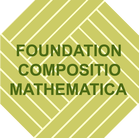Singularities in Positive Characteristic
Singularités en caractéristique positive
12 – 16 July 2021
|
Scientific Committee
Comité scientifique Dale Cutkosky (University of Missouri) |
Organizing Committee
Comité d’organisation Angelica Benito (Autonomous University of Madrid) |
|
Singularity theory studies classification problems of non-generic situations of functions, maps, and spaces. It is an area at the crossroads of geometry, algebra, and topology. However, the backbone of singularity theory comes from algebra, in particular commutative algebra. When studying algebraic varieties over fields of prime characteristic, one is often forced to resort to purely algebraic methods, since our geometric understanding in this situation is considerably less developed than over characteristic zero fields. Very recently, new techniques developed in commutative algebra yield exciting and (sometimes geometrically) unexpected results, in particular in the realm of positive characteristic singularities.
Ever since Hironaka’s 1964 proof of resolution of singularities of algebraic varieties over a field of characteristic zero, there solution of singularities has been an important tool in algebraic geometry. Although there have been recent advances, a proof for characteristic p is still wide open in dimen-sion>3. In particular, differential methods, i.e., the study of differential operators, D-modules, and invariants there of, crystalize to be useful to tackle the problem of desingularization in prime characteristic. This conference will focus on the interaction between the classical study of singularities in characteristic p (making use of the Frobenius morphism to investigate and classify singularities) and resolution of singularities in characteristic p, with a focus on differential methods. Our aim is to bring together international experts in these areas in order to communicate and exchange ideas. This conference will in particular allow early career mathematicians to interact with established researchers and develop their research programs. |
La théorie des singularités étudie les problèmes de classification des situations non génériques de fonctions, de morphismes, et d’espaces en géométrie algébrique, analytique, et différentielle. Elle se situe à l’intersection de l’algèbre, de la géométrie, et de la topologie. Cependant l’algèbre, et en particulier l’algèbre commutative, y joue un rôle essentiel.
La géométrie algébrique sur les corps de caractéristique positive doit souvent faire appel à des méthodes purement algébriques car notre compréhension géométrique est bien plus limitée dans ce cadre qu’en caractéristique zéro. Des techniques d’algèbre commutative développées récemment ont fourni des résultats stimulants, parfois inattendus du point de vue géométrique, particulièrement dans l’étude des singularités en caractéristique positive. Depuis sa démonstration par Hironaka en 1964 en caractéristique zéro, la résolution des singularités a été un outil très important en géométrie algébrique. Malgré des progrès récents, le cas de caractéristique positive est encore complètement ouvert en dimension >3. Les méthodes dif-férentielles, c’est à dire l’étude des opérateurs différentiels, des D-modules et de leurs invariants, paraissent de plus en plus utiles dans l’attaque de ce problème. Cette conférence se concentrera sur l’intéraction entre l’étude classique des singularités en caractéristique p (utilisant le morphisme de Frobenius) et d’autre part la résolution des singularités en caractéristique positive, en mettant l’accent sur les méthodes différentielles. Notre but est de réunir les experts internationaux dans ces domaines pour créer des échanges d’idées. Cette conférence permettrait en particulier aux mathématiciens qui sont au début de leur carrière d’interagir avec des chercheurs confirmés et de développer leur programme de recherche. |
Dan Abramovich (Brown University) Stacks in the service of resolution
Josep Àlvarez Montaner (Polytechnic University of Catalonia) Bernstein’s inequality and holonomicity for certain singular rings
Ana Bravo (Autonomous University of Madrid) The asymptotic Samuel function and refinements of the multiplicity
Tommaso de Fernex (University of Utah) Motivic integration on Berkovich spaces
Daniel Erman (University of Wisconsin-Madison) Tate resolutions for toric varieties
Charles Favre (École Polytechnique) Dynamical monomialization
Anne Frühbis-Krüger (University of Oldenburg) Embedded desingularization of arithmetic surfaces — from the algorithmic side
Franz-Viktor Kuhlmann (University of Szczecin) News from the defect
Linquan Ma (Purdue University) A Buchsbaum theory for tight closure
Hussein Mourtada (Université de Paris) On the notion of quasi-ordinary singularities in positive characteristics: Teissier singularities and their resolution
Luis Narváez Macarro (University of Seville) On Hasse-Schmidt derivations in nonzero characteristic
Luis Núñez-Betancourt (CIMAT) Nash blowups in prime characteristic
Janet Page (University of Michigan) Extremal Singularities in Positive Characteristic
Olivier Piltant (Université de Versailles Saint-Quentin) Some remarks about additive polynomials of degree p in characteristic p>0
Ana Reguera (University of Valladolid) Some peculiarities of the space of arcs in positive characteristic
Mark Spivakovsky (Université Toulouse III Paul Sabatier) The local uniformization problem via normal forms of limit key polynomials and universal
Michael Temkin (The Hebrew University of Jerusalem) Logarithmic geometry in the service of resolution
Kevin Tucker (University of Illinois at Chicago) Openness of splinter loci in prime characteristic
Michel Vaquie (CNRS Institut de Mathématiques de Toulouse) Augmented valuation, minimal pair and approximate valuation
Emily Witt (University of Kansas) Cubic surfaces of characteristic two



